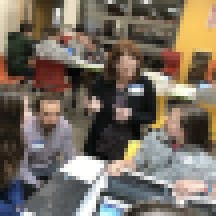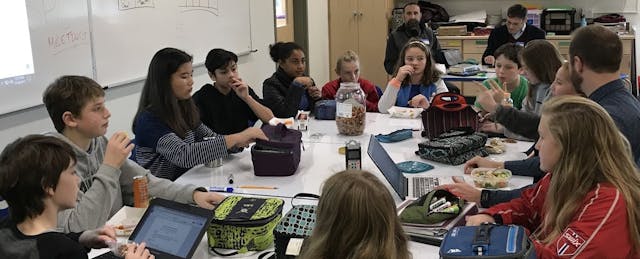It’s a cold morning in northern Vermont, so Peter Nichols has the heat cranked high as he pulls out of his driveway and begins the 66-mile drive south, out of the rural hills surrounding Hazen Middle School, where he teaches, and towards the lakefront properties of Shelburne Community School.
He is making the trip to visit Sam Nelson and his middle schoolers who have formed a student planning committee, a group of students who meet regularly with Nelson to help him refine his curriculum. Nelson’s early findings sound promising. Nichols is intrigued.
Nichols and Nelson are part of a network of Vermont learning labs devoted to getting personalization right. Funded by the Tarrant Institute for Innovation in Education (TIIE), these labs are led by educators who are ready to partner with their peers to experiment with practices that make learning more meaningful.
Site visits play a key role in the learning lab experience. To attract visitors, our learners post their inquiry-based questions on their educator profiles, skimmable overviews of each educator’s learning lab that include a map pinning each site’s location. A “Schedule a Visit” button makes it simple to arrange a visit, something Nichols did weeks ago.

As Nichols pulls into Shelburne Middle School, thoughts of his sub plans fade as excitement builds for what lies ahead: a morning in a well-funded school, where students arrive ready to learn in a state-of-the-art facility. (Over 60 percent of the students at Nichols’ school come from low income families, a significant contrast to Shelburne’s 14.7 percent.)
Nelson and his students greet Nichols and introduce a team of educators from Rutland who have also come to see the student planning committee in action.
Nelson leads the group through a newly renovated library to the school’s new wing. Nichols soaks it all in. The vibrant colors and contemporary design make the school feel less institutional and more homey. “Here’s where our team lives and where I teach,” Nelson says, leading his visitors into a central, open room from which you can see through large glass windows into four classrooms that surround it. This is Winton House, one of three grade 6-8 teams at Shelburne. The guests “ooh” and “aah.” “I know,” says Nelson. “Please don’t hate us too much.”
The visitors settle into Nelson’s classroom to learn more about the student planning committee, which includes about a dozen students who meet once a week during lunch. It’s informal, yet focused. “At first, I just talked with them about how class was going. They weren’t bashful. Then I started sharing what we would be doing in an upcoming unit, and wow, what a difference!”

During lunch, Nelson and the Rutland group observe and engage the committee as they offer ideas for some upcoming lessons. Nichols notes the quality of the students’ ideas, their empathy for peers who learn differently and their fluency with the language of proficiency-based learning.
He is beginning to think doing something like this back at Hazen might be quite helpful to his practice so he pulls Nelson aside and gets a few more pressing questions answered.
We recently asked Nichols about his takeaways from this visit. “Honestly, heading into it I was worried I’d just get a bad case of resource envy. But that didn’t happen. I got a lot out of it.” As did his students. Within one week of the visit, Nichols formed his own committee and immediately experienced what Nelson and his students had described.
Word of these impactful student planning committees spread across our network, and Peter Stratman, who teaches in Cabot, Vermont, decided to bring some of his students to visit Nelson’s classroom. Inspired by the experience, Stratman formed a student leadership council on the drive home; the group established a mission and goals, which they now use to guide conversation during their weekly Wednesday lunch meetings.
Stratman says he often feels the need to have things worked out before jumping in but that seeing Nichol’s fast success and visiting Nelson’s school inspired him to just try it.
Three weeks later, these three teachers and their students submitted a proposal to present their findings at Dynamic Landscapes, a local education conference. The proposal was accepted; they present on May 21.
We are two long-time public school teachers turned professional developers. In 2016, we teamed up to design a year-long, graduate-level practicum that models for teachers the very kind of personalized learning conditions we want them to create for their students.
A year into implementation, our minds our blown. And while these site visits are a critical piece of the puzzle, it’s important to rewind and place them in context.
All of our learners work in schools affiliated with TIIE, a think tank at the University of Vermont that offers middle schools intensive professional development, grant funding and new technology in exchange for a commitment to technology-rich school change that places students at the center.
Administrators and coaches from the 50 middle schools that have partnered with TIIE recommend educators to apply for the practicum. As part of the process, applicants commit to sharing their findings with their colleagues and the field. They also opt for three graduate credits or a stipend.
Long before our learners consider hosting or making visits, we meet for a full day in the summer to get to know each other and to get clear about the sequence of our work and the learning that matters most. Before asking our learners to draft their learning biographies, we share ours. We unpack the pivotal moments that continue to inform who we are and our approach to teaching and learning—the third grade teacher that inspired, the summer camp that transformed, the family tragedy that changed everything.
This is personal stuff, by design. Simply getting teachers to visit each other’s classrooms, while admirable, doesn’t lead to the kind of deep exchanges that make the change we’re looking for. For these visits to really pay off, trust and respect need to be solid.
From the get go, we urge our learners to be open with each other. We host Friday afternoon socials, publish weekly huddles to connect, inspire, and inform our network, and twice during the year we meet for an overnight at the Common Ground Center in Starksboro. We tell bad jokes and poke fun at each other. We stay in touch through Slack and Google hangouts, and we provide site-based coaching for our learners.
As the level of trust in our circle grows, teachers begin opening up about where they need support. Teachers need these kinds of relationships and this sense of community if they’re going to commit to the complex, creative and challenging work of getting personalization right.
Here are five suggestions for those of you ready to take a do-it-yourself approach to making these kind of high impact, cross-site classroom connections work.
- Locate a teacher you respect at another site within driving distance and consider setting up an exchange between your classrooms.
- Involve students by setting up a Google hangout or Flipgrid so they can get to know each other and practice being part of a classroom exchange.
- Make visits active observations so guests and hosts engage with each other (Here are two documents we use to help with this: How to Be the Host with the Most & How to Be the Best Guest.)
- Conclude the visit with a debrief so visitors can reflect, wonder and pose questions about their experience.
- Capture and document the day so you can share the story. (Here’s a look at the Shelburne Community School visit we highlighted.)
The learning lab experience, rooted in an intentional community of trust and respect, inspires Vermont educators to accelerate innovation by opening up their classrooms and tapping into the collective wisdom of the group. Our educators aren't only sharing the shiny, perfect parts, but also the crash-and-burn moments. And it's this "straight talk" approach that is catalyzing change across our network.


